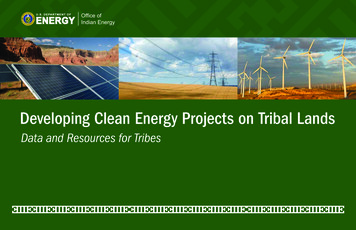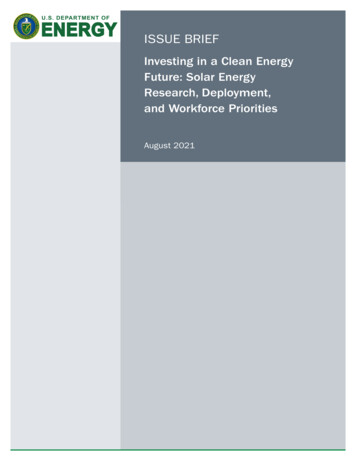
Transcription
Developing Clean Energy Projects on Tribal LandsData and Resources for Tribes
Table of ContentsKey Findings . . . . . . . . . . . . . . . . . . . . . . . . . . . . . . . . . . . . . . . . . . . . . . 3About the DOE Office of Indian Energy . . . . . . . . . . . . . . . . . . . . . . . . . . . . 4U.S. Market Context and Clean Energy Investments . . . . . . . . . . . . . . . . . 11Renewable Energy Resource Technical Potential on Tribal Lands . . . . . . . . 29Biomass . . . . . . . . . . . . . . . . . . . . . . . . . . . . . . . . . . . . . . 34Concentrating Solar Power . . . . . . . . . . . . . . . . . . . . . . . . . 38Geothermal . . . . . . . . . . . . . . . . . . . . . . . . . . . . . . . . . . . . 42Hydropower . . . . . . . . . . . . . . . . . . . . . . . . . . . . . . . . . . . . 46Solar Photovoltaics . . . . . . . . . . . . . . . . . . . . . . . . . . . . . . 50Wind . . . . . . . . . . . . . . . . . . . . . . . . . . . . . . . . . . . . . . . . . 54Capturing the Potential: Key Questions and Next Steps . . . . . . . . . . . . . . 59Additional Resources . . . . . . . . . . . . . . . . . . . . . . . . . . . . . . . . . . . . . . . . 712Developing Clean Energy Projects on Tribal Lands
Renewable Energy Technical Potential on Tribal LandsThe U.S. Department of Energy (DOE) Office of Indian Energy Policy and Programs commissioned an updated estimate ofrenewable energy potential on Indian lands to reflect and incorporate fast-moving renewable technology efficiency innovations. Updated data was analyzed by the DOE Office of Indian Energy and by DOE’s National Renewable Energy Laboratory(NREL), which used geospatial methodology to update and substantiate the estimated renewable energy technical potential on tribal lands. The purpose is to provide tribal governments with data to make informed decisions about renewabledevelopment options for their communities.Key Findings American Indian land comprises approximately 2% of U.S. land but contains an estimated 5% of allrenewable energy resources. The total technical potential on tribal lands for electricity generation from utility-scale rural solarresources is about 14 billion MWh, or 5.1% of total U.S. generation potential. The total technical potential on tribal lands for electricity generation from wind resources is about1,100 million MWh, or about 3.4% of the total U.S. technical potential. The total technical potential on tribal lands for electricity generation from hydropower resources isabout 7 million MWh, or about 2.9% of the total U.S. technical potential.Developing Clean Energy Projects on Tribal Lands3
About the DOE Office of Indian Energy
About the DOE Office of Indian EnergyEmpowering Indian Country to Energize Future GenerationsThe DOE Office of Indian Energy was established by Congressto provide federally recognized Tribes and Alaska Native entitieswith technical and financial assistance to encourage, facilitate,and assist in energy and energy infrastructure development inIndian Country.In direct response to the requests of Tribes and Alaska NativeTribes, DOE Office of Indian Energy has designed key programsto provide tribal leaders and staff with the knowledge neededto make informed energy decisions — decisions with the powerto help: Stabilize energy costs Enhance energy security Strengthen tribal energy infrastructure Promote tribal self-determination.By providing reliable, accurate information and expert technicalassistance, the DOE Office of Indian Energy seeks to empowerTribes by providing analytical tools and technical support to bolster tribal leadership decision making, and the next generationof energy development in Indian Country.To learn more about the history of the Office and its programmission, please visit www.energy.gov/IndianEnergy.At the Indian Pueblo Cultural Center in Albuquerque, New Mexico,this photovoltaic carport delivers about 23 megawatt-hours ofclean electricity to the local utility grid. Photo from Sandia NationalLaboratories, NREL 08978Developing Clean Energy Projects on Tribal Lands5
About the DOE Office of Indian EnergyA Shared Path Toward a Sustainable Energy FutureThe DOE Office of Indian Energy’s approach is, first and foremost, a collaborative one as it works with tribal nations, federalagencies, state governments, non-governmental organizations,and the private sector to support tribally led development of theconsiderable energy resources that exist.To guide the strategic planning and implementation of theDepartment’s tribal energy programs and policies, EnergySecretary Steven Chu established an Indian Country Energyand Infrastructure Working Group (ICEIWG). In addition, theDOE Office of Indian Energy has launched three near-termstrategic initiatives to support the tribal energy developmentand capacity-building priorities established in the Congressionalstatute defining the DOE Office of Indian Energy’s mission: Strategic Technical Assistance Response Team(START) Programs Tribal Energy Education Programs Tribal Leader and Best Practices Forums.Through the Indian Country Energy and Infrastructure Working Group,DOE Office of Indian Energy collaborates and identifies real-time tribalexperiences representing obstacles and opportunities in energy andrelated infrastructure development and capacity building in IndianCountry. Photo from Brooke Oleen, National Conference of StateLegislaturesThe DOE Office of Indian Energy coordinates and manages the government-to-government and intertribal collaboration involved in carrying out all DOEtribal energy-related activities and initiatives prescribed through the Energy Policy Act of 2005.6Developing Clean Energy Projects on Tribal Lands
About the DOE Office of Indian EnergyDOE Indian Energy START ProgramsTo better position tribal energy and infrastructure projects for financingand construction, the DOE Office of Indian Energy Strategic TechnicalAssistance Response Team (START) Programs provide community-basedassistance to federally recognized Native American and Alaska Native villages through clean energy and infrastructure expert technical assistanceand support. This support ranges from technical resource analysis, development process assistance, and infrastructure evaluation, to communitywide energy planning, workforce training, and project financial support.DOE START Programs seek to spur clean energy and infrastructure projectdevelopment by providing Tribes with tools and resources needed tofoster energy self-sufficiency, sustainability, and economic competitiveness. With core support of technical experts from NREL, START workshand-in-hand at the community level with tribal leadership and staff.Other On-the-Ground Technical AssistanceIn addition to START, the DOE Office of Indian Energy routinely pulls inthe diverse array of expertise across the DOE complex, including itsnational energy laboratories and other expert partners to offer Tribesunbiased technical expertise on energy projects. Other assistance hasincluded installing renewable energy systems, facilitating strategicpartnerships and discussions, and implementing solutions to energyand environmental challenges.START team members conduct a wind site assessment on theCampo Indian Reservation in San Diego County, California.From left to right: Bob Springer, NREL; Laura Quaha, CampoKumeyaay Nation: Melissa Estes, Campo EnvironmentalProtection Agency; Robi Robichaud, NREL. Photo by AlexDane, NREL 22724Developing Clean Energy Projects on Tribal Lands7
About the DOE Office of Indian EnergyTribal Leader Education ProgramsTo enhance tribal leaders’ understanding of energy projectdevelopment, including DOE’s role, business processes, andproject frameworks, the DOE Office of Indian Energy works withnumerous partners to develop education and technical assistance materials available to tribal leaders and staff throughregional workshops and online webinars. These partners includeother DOE offices, laboratories, and programs, such as NREL,Sandia National Laboratories, the Office of Energy Efficiency andRenewable Energy’s (EERE) Tribal Energy Program, the Office ofElectricity, Western Area Power Administration, and BonnevillePower Administration.Tribal Leader and Best Practices ForumsTo further support smart tribal energy development throughcollaboration and information sharing, the DOE Office of IndianEnergy hosts strategic best practices forums on energy technologies and energy project development and finance. The forumsare designed to give tribal leaders an opportunity to receive thelatest updates from and interact directly with, Tribes, industry,utilities, DOE, and other federal agencies on tribal energy deployment efforts.8Developing Clean Energy Projects on Tribal LandsAttendees at one of the DOE Office of Indian Energy’s Tribal LeaderEnergy Forums. Photo by Dennis Schroeder, NREL 23633
About the DOE Office of Indian EnergyResources for TribesThe DOE Office of Indian Energy offers a number of resources to support the development of renewable energy resources on tribal lands.Energy Resource LibraryThe DOE Office of Indian Energy’s Web-based Energy ResourceLibrary provides links to more than 100 publications, websites, andother helpful resources for Tribes on energy project developmentand financing in Indian Country. Topics include community-scaledevelopment, legal and regulatory issues, project checklists, strategic energy planning, renewable energy technologies, transmission,tribal case studies, and more: rce-library.DOE OFFICE OF INDIAN ENERGYFoundational CoursesEnergy BasicsELECTRICITY GRID BASICSPresented by the National Renewable Energy LaboratoryRenewable Energy CurriculumDOE Office of Indian Energy has developed an educational trainingprogram that provides tribal leaders and professionals with an overview of the project development process and financing of renewableenergy projects on tribal lands. The program includes foundationalcourses that give a baseline understanding of energy strategy, planning, and resources, as well as advanced leadership and professionalcourses that take an in-depth look at the energy project developmentframework and various financing options. The webinars are availableon the National Training & Education Resource (NTER) website:www.nterlearning.org.Developing Clean Energy Projects on Tribal Lands9
About the DOE Office of Indian EnergyResources for Tribes (continued)Tribal Renewable Energy Webinar SeriesThe DOE Office of Indian Energy, the EERE Tribal Energy Program,and Western Area Power Administration sponsor a series of freewebinars on tribal renewable energy. The webinars are designedfor tribal leaders and staff members who are interested in developing commercial-scale projects, responding to utility offeredrequests for proposals, and/or learning more about the competitive power market. To see a schedule of upcoming webinars andlinks to register, visit d-training.NewsletterThe DOE Office of Indian Energy quarterly newsletter, IndianEnergy Beat, highlights opportunities and actions to accelerateenergy development in Indian Country: 0Developing Clean Energy Projects on Tribal Lands
U.S. Market Context andClean Energy Investments
U.S. Market Context and Clean Energy InvestmentsU.S. Energy Production and Consumption (2011)U.S. Energy Production (2011): 78.0 Quadrillion BtuCoal: 28.4%Nuclear: 10.6%U.S. Renewable Energy Production:9.2 Quadrillion BtuRenewables: 11.7%Natural Gas:33.9%Petroleum: 15.4%o:ydr%4.1H.7%.5% 0.1% 0.3%:::5:1ssnd olar rmaliWS themaBiooGeU.S. Energy Consumption (2011): 97.5 Quadrillion BtuCoal: 20.4%Nuclear: 8.5%Natural Gas:25.5%U.S. Renewable Energy Consumption:9.0 Quadrillion BtuRenewables: 9.3%Petroleum: 36.2%.3%:3Hoydr%.2% 0.1% 0.2%4.5:::1ss:nd olar rmaliaWS themBiooGeSource: EIA; full references are provided starting on p. 72. Note: Energy consumption is higher than energy production due to oil imports. All data reported as primary energy.12Developing Clean Energy Projects on Tribal Lands
U.S. Market Context and Clean Energy InvestmentsU.S. Energy Production by Energy Source (2000–2011)CoalNatural Gas*PetroleumNuclearRenewablesTotal Production(Quadrillion 0.9%74.8201128.4%33.9%15.4%10.6%11.7%78.0Source: EIA. *Includes natural gas plant liquids. Note: Annual totals may not equal 100% due to rounding.Developing Clean Energy Projects on Tribal Lands13
U.S. Market Context and Clean Energy InvestmentsU.S. Energy Consumption by Energy Source (2000–2011)CoalNatural GasNuclearRenewablesTotal Consumption(Quadrillion 1120.4%25.5%36.2%8.5%9.3%97.5Source: EIA14PetroleumDeveloping Clean Energy Projects on Tribal Lands
U.S. Market Context and Clean Energy InvestmentsU.S. Electricity Nameplate Capacity and Generation (2011)U.S. Electric Nameplate Capacity (2011): 1,146 GWCoal: 30.3%Nuclear: 9.3%U.S. Renewable Capacity: 146 GWRenewable Energy: 12.8%Natural Gas: 41.8%Other: 0.4%Petroleum: 5.5%o:ydr%6.8WH%% %0.4 l: 0.3 s: 1.2:*asalar mSo other BiomeG%4.1:indU.S. Electric Net Generation (2011): 4,117 million MWhNuclear: 19.2%Coal: 42.1%U.S. Renewable Generation: 526 million MWhRenewable Energy: 12.8%Other: 0.5%Petroleum: 0.7%Natural Gas: 24.7%o:ydrH%7.9.2% .4% .4%r : 0 al: 0 ss: 1alSo therm iomaBoGe.9%:2ndWiSources: EIA, GEA, LBNL, SEIA/GTM, Larry Sherwood/IREC. Other includes: pumped storage, batteries, chemicals, hydrogen, pitch, purchased steam, sulfur, tire-derived fuels, and miscellaneous technologies. *On-grid capacity only.Developing Clean Energy Projects on Tribal Lands15
U.S. Market Context and Clean Energy InvestmentsU.S. Electric-Generating Capacity by Source (2000–2011)CoalPetroleumNatural GasOtherGasesNuclearOtherTotal 3%5.5%41.8%0.3%9.3%12.8%0.1%1,145,741Sources: EIA, GEA, LBNL, SEIA/GTM, Larry Sherwood/IREC16RenewablesDeveloping Clean Energy Projects on Tribal Lands
U.S. Market Context and Clean Energy InvestmentsU.S. Electricity Generation by Source ralGasOtherGasesNuclearRenewablesOtherTotal Generation(million %24.7%0.3%19.2%12.8%0.3%4,117,287Sources: EIA, GEA, LBNL, SEIA/GTM, Larry Sherwood/IRECDeveloping Clean Energy Projects on Tribal Lands17
U.S. Market Context and Clean Energy InvestmentsU.S. Energy Consumption by Sector (2011)U.S. Energy Consumption in 2011 was 97.5 Quadrillion BtuIndustrial: 31.5%Commercial: 18.6%U.S. buildingsrepresent 40.8%of energy use.Residential: 22.2%Source: EIA18Developing Clean Energy Projects on Tribal LandsTransportation: 27.7%
U.S. Market Context and Clean Energy InvestmentsU.S. Energy Consumption – Residential and Commercial (2011)Residential Energy Consumption(21.7 Quadrillion Btu) – 2011Electricity RetailSales: 22.4%Commercial Energy Consumption(18.1 Quadrillion Btu) – 2011 Electricity RetailSales: 24.9%Electrical SystemEnergy Losses:47.4%Renewables: 2.6%Petroleum: 5.3%Electrical SystemEnergy Losses:52.5%Renewables: 0.7%Petroleum: 3.8%Natural Gas: 17.8%Natural Gas: 22.3%Coal: 0.03%Coal: 0.3%Source: EIADeveloping Clean Energy Projects on Tribal Lands19
U.S. Market Context and Clean Energy InvestmentsU.S. Energy Consumption – Industrial and Transportation (2011)Industrial Energy Consumption(30.7 Quadrillion Btu) – 2011Transportation Energy Consumption(27.1 Quadrillion Btu) – 2011Natural Gas: 27.1%Petroleum: 26.3%Natural Gas: 2.7%Renewables: 4.2% Electricity Retail Sales: 0.1% Electrical System EnergyLosses: 0.2%Coal: 5.4%Electrical SystemEnergy Losses: 22.9%Renewables: 7.5%Electricity RetailSales: 10.8%Source: EIA20Developing Clean Energy Projects on Tribal LandsCoal: 0.0%Petroleum: 92.8%
U.S. Market Context and Clean Energy InvestmentsClean Energy Investments: Summary U.S. investment in renewable energy has grown dramatically in the past decade,and in 2011 annual investment reached more than 35 billion. U.S. investment in wind energy projects grew from 378 million in 2001 to more than 5 billion in 2011. In 2011, U.S. venture capital and private equity investment in renewable energy technologycompanies was nearly 7 billion—up from 253 million in 2001. U.S. venture capital and private equity investment in solar technology companies hasincreased from 50 million in 2001 to more than 1.7 billion in 2011.*All figures in 2011 real dollars.Developing Clean Energy Projects on Tribal Lands21
U.S. Market Context and Clean Energy InvestmentsU.S. and Global Total Investment in Renewable Energy (2011)U.S. Total InvestmentGlobal Total Investment150,00040,00035,000 35,46430,000 136,094Advanced TransportationDigital Energy120,000Carbon Capture & Storage20,00015,00010,000Fuel Cells/HydrogenEnergy ndSolar5,000 in Millions in MillionsMarine25,00030,000Biofuels0Source: Bloomberg New Energy Finance. Completed and disclosed deals only. Does not adjust for undisclosed transactions. Includes VC/PE, public market activity, and asset financing.22Developing Clean Energy Projects on Tribal Lands
U.S. Market Context and Clean Energy InvestmentsLifetime or Levelized Costs of Renewables 0.60Levelized cost of energy /kWh 0.50 0.40 0.30 0.20 0.10 entratingSolar ologySource: Selected data presented by NREL from “LCOE – Transparent Cost Database.” (2012). OpenEI. Accessed February 4, 2013: http://en.openei.org/apps/TCDB/.Developing Clean Energy Projects on Tribal Lands23
U.S. Market Context and Clean Energy InvestmentsU.S. Wind Energy Project Asset Financing Transactions (2001–2011) 12,59513,000 11,68612,00011,00010,0009,000 in Millions 9,636 9,566 8,3498,0007,0006,000 5,304 4,6965,0004,0003,000 2,0812,0001,0000 378 28720012002 6822003200420052006*All figures in 2011 real dollars. Figures represent disclosed deals derived from Bloomberg New Energy Finance’s Desktop database.24Developing Clean Energy Projects on Tribal Lands20072008200920102011
U.S. Market Context and Clean Energy InvestmentsU.S. Venture Capital and Private Equity Investment in Solar Energy TechnologyCompanies (2001–2011)3,000 2,8782,500 2,134 in Millions2,000 1,801 1,748201020111,500 1,0391,000 4465000 243 50 50 68 72200120022003200420052006200720082009*All figures in 2011 real dollars. Figures represent disclosed deals derived from Bloomberg New Energy Finance’s Desktop database.Developing Clean Energy Projects on Tribal Lands25
U.S. Market Context and Clean Energy InvestmentsU.S. Venture Capital and Private Equity Investment in Biofuels TechnologyCompanies (2001–2011) 1,9792,0001,8001,600 in Millions1,400 1,2311,200 1,0161,000800 698600 691 4824002000 252 31 2920012002 90 472003200420052006*All figures in 2011 real dollars. Figures represent disclosed deals derived from Bloomberg New Energy Finance’s Desktop database.26Developing Clean Energy Projects on Tribal Lands20072008200920102011
U.S. Market Context and Clean Energy InvestmentsU.S. Venture Capital and Private Equity Investment in Renewable EnergyTechnology Companies (2001–2011)Advanced TransportationDigital EnergyCarbon Capture & StorageMarineFuel Cells/HydrogenEnergy Storage6,000 in Millions5,0004,000 3,927 3,436BiopowerGeothermalWindSolarBiofuels2,0001,000 353 38320012002 5,591 5,237Efficiency3,0000 6,929 6,8917,000 2,546 695 849200320042005200620072008200920102011*All figures in 2011 real dollars. Figures represent disclosed deals derived from Bloomberg New Energy Finance’s Desktop database.Developing Clean Energy Projects on Tribal Lands27
U.S. Market Context and Clean Energy InvestmentsPublic Renewable Energy Index Performance (2011) (Indexed to 100)120(1%)100(8%)80(34%)(41%)60S&P 500(43%)New Alternatives Fund (NALFX)40Calvert Global Alternative Energy Fund (CGAEX)WilderHill New Energy Global Index (DJIA: NEX)20Guinness Atkinson Alternative Energy Fund lic data. Index performance is calculated as a percentage of the fund or index price as of January 2, 2011. The four indices and funds shown above experienced declines in price while the S&P 500 remained relatively stable in 2011.28Developing Clean Energy Projects on Tribal Lands
Renewable Energy ResourceTechnical Potential on Tribal Lands
Renewable Energy Resource Technical Potential on Tribal LandsAnalysis of Renewable Energy Resource Technical Potential on Tribal LandsDOE Office of Indian Energy, in coordination withNREL, has prepared a geospatial analysis of the technical potential of renewable energy on tribal lands.According to the analysis, American Indian landcomprises approximately 2% of U.S. land but containsan estimated 5% of all renewable energy resources.How Can Tribes Use This Information?Tribes that wish to pursue renewable energyprojects can use this information to determinethe market or developable potential of renewableenergy. This includes: Conducting an assessment of broadertribal interests in development (e.g., scaleof project, purpose of project, culturalsensitivity avoidance) Understanding the energy environmentin which the project would function as away of assessing potential project viabilityand economics Working with the local utility and regulatoryauthorities to understand renewableenergy needs.30Developing Clean Energy Projects on Tribal LandsBenefits of PursuingClean Energy Developmenton Tribal Lands Long-term stabilization ofenergy costs Economic development Revenue generationopportunity Opportunity to conserve andsustain natural resources Energy self-sufficiency Strengthened tribal energyinfrastructureDuring a START site visit, START team member Alex Dane (NREL) repaired the trackingmotor of the community-owned solar photovoltaic array in Venetie, Alaska. Photo byBrian Hirsch, NREL 20893.
Renewable Energy Resource Technical Potential on Tribal LandsWhat Is Technical Potential?Technical potential identifies the types of renewable energy resources available in a specificlocation and how much energy those resourcescan produce. This is important for helping Tribesprioritize which renewable energy resources todevelop and how those resources can generaterevenue for the Tribe.Technical potential is determined by narrowingthe resource potential to exclude topographicconstraints and land-use constraints whiletaking into account system performance. Thedata in this brochure was generated usinggeospatial methodology, which is an approachto analyzing information that incorporates datathat has a geographic component and allows fora more refined analysis of technical potential forall Tribes by parsing it to individual tribal lands.This brochure includes summary informationon specific renewable energy technologies.Detailed information can be found in the fullreport, which will be available on the DOE Officeof Indian Energy website in early 2013.Key AssumptionsPotential Physical Constraints Theoretical Physical Potential Energy Content of Resource System/Topographic Constraints Land-Use Constraints System PerformanceResourceTechnicalEconomic Projected Technology Costs Projected Fuel Costs Policy Implementation/Impacts Regulatory Limits Investor Response Regional Competition with Other Energy ResourcesMarketDeveloping Clean Energy Projects on Tribal Lands31
Renewable Energy Resource Technical Potential on Tribal LandsSummary of Tribal Renewable Energy Installed Capacity1American Indian land comprises 2% of U.S. land but contains an estimated 5% of all renewable energy resources.Megawatts (MW) of Tribal Capacity Potential2MW of National Capacity Potential2Total 4 9,083,993Total 4 202,146,961Solar CSP:20%Wind: 4%Wind: 5%Hydropower: 0.02%Biomass (Solid): 0.01%Geothermal(Hydrothermal): 0.01%Hydropower: 0.03%Biomass (Solid): 0.02%Biomass (Gaseous): 0.01%Geothermal(Hydrothermal): 0.01%Solar PV(Rural Utility Scale): 76%Solar PV(Rural Utility Scale): 76%Notes: N umbers may not add up to 100% as a result of rounding.Urban PV and geothermal Enhanced Geothermal System (EGS) were not included in the estimates.32Solar CSP:19%Developing Clean Energy Projects on Tribal LandsReferences on page 74
Renewable Energy Resource Technical Potential on Tribal LandsSummary of Tribal Renewable Energy Generation PotentialMegawatt-hour (MWh) of Tribal Generation3 Potential2MWh of National Capacity Potential2Total 4 21,631,785,869Total 4 430,527,524,682Solar CSP:28%Wind: 5%Hydropower: 0.06%Biomass (Solid): 0.02%Geothermal(Hydrothermal): 0.02%Solar CSP:27%Wind: 8%Biomass (Solid): 0.09%Hydropower: 0.06%Geothermal(Hydrothermal): 0.05%Biomass (Gaseous): 0.02%Solar PV(Rural Utility Scale): 66%Notes: N umbers may not add up to 100% as a result of rounding.Urban PV and geothermal EGS were not included in the estimates.Solar PV(Rural Utility Scale): 65%References on page 74Developing Clean Energy Projects on Tribal Lands33
Biomass
Renewable Energy Resource Technical Potential on Tribal LandsBiomassBiomass has been used for electric power generation for manyyears. It can be a cost-effective, carbon-neutral dispatchablesource of electrical power. Most biopower plants use direct-firedsystems to generate electricity from biomass. They burn bioenergyfeedstocks directly to produce steam. This steam drives a turbine,which turns a generator that converts the power into electricity.In some biomass industries, the spent steam from the powerplant is also used for manufacturing processes or to heat buildings. Such combined heat and power systems greatly increaseoverall energy efficiency.Types of Biomass Wood from various sources (beetle kill, slash, lumber waste) Agricultural residues Animal and human waste (methane) Municipal solid waste and landfill gasBenefits of Biomass Reduced greenhouse gas emissions Less dependence on foreign oil Supports the U.S. agricultural and forest-product industriesElectricity Production 1 megawatt (MW) to 10 MW of biomass energy can powercommunity-scale facilities like lumber mills, tribal villages,or casinos. Larger systems ( 5 MW) typically have better economicsand can power commercial-scale facilities such as hotels,schools, and recreation centers.Costs Installed costs are 1,900– 5,500/kW for a communityscale facility. A larger, commercial-scale biomass application can costapproximately 40 million for 10 MW. The levelized cost of energy (LCOE) for biomass is .08 to 0.94/kilowatt-hour (kWh) depending on feedstock cost.A more typical range is 0.08 to 0.20/kWh.Learn MoreGet an overview of biomass renewable energy byaccessing DOE Office of Indian Energy’s RenewableEnergy Curriculum for Tribes at www.nterlearning.org.Developing Clean Energy Projects on Tribal Lands35
Renewable Energy Resource Technical Potential on Tribal LandsBiomassThe total technical potential for electricity generation from solid biomass on tribal lands is about 4 million MWh or about 1.1% of thetotal U.S. technical potential. Developable potential of biomass resources is often limited by the market costs of transporting the fuel.Top Five Tribal Lands with Biomass Capacity and Generation PotentialNameNez PerceLake Traverse (Sisseton)YakamaCoeur d’AleneMenominee36State(s)Biopowerfrom SolidResidues (MWh)Biopowerfrom GaseousResidues (MWh)Biopowerfrom SolidResidues (MW)Biopowerfrom GaseousResidues (MW)ID336,781104430.01MN, ND, SD300,46697380.01WA274,750329350.04ID, WA264,73784340.01WI246,14542310.01Developing Clean Energy Projects on Tribal Lands
Renewable Energy Resource Technical Potential on Tribal LandsTribal Lands BiomassGeneration PotentialDeveloping Clean Energy Projects on Tribal Lands37
Concentrating Solar Power
Renewable Energy Resource Technical Potenti
To enhance tribal leaders' understanding of energy project development, including DOE's role, business processes, and project frameworks, the DOE Office of Indian Energy works with numerous partners to develop education and technical assis-tance materials available to tribal leaders and staff through regional workshops and online webinars .











